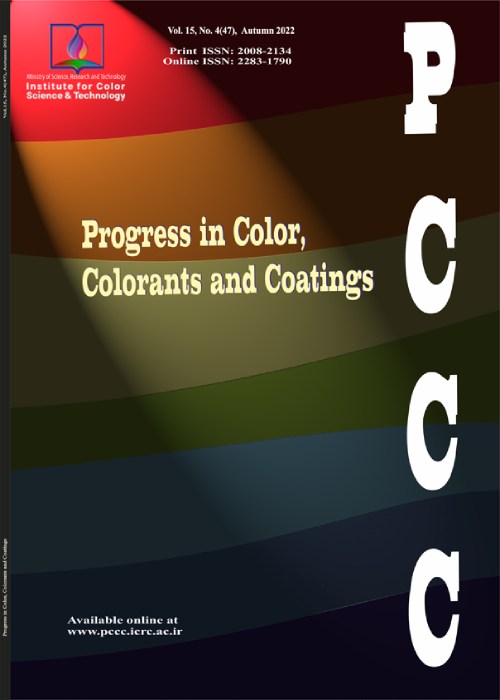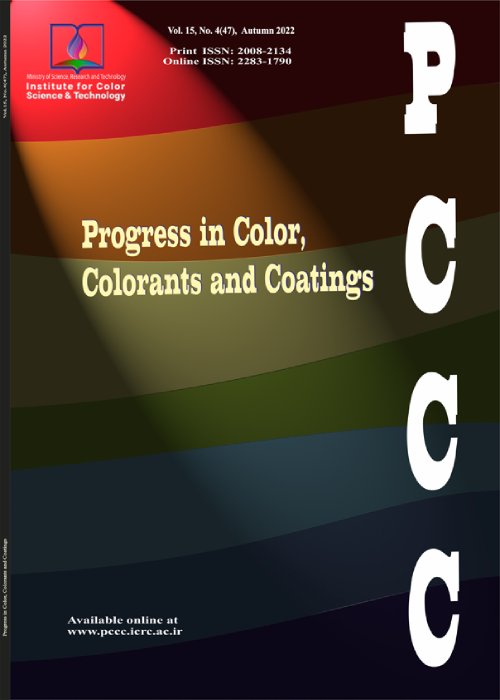فهرست مطالب

Progress in Color, Colorants and Coatings
Volume:16 Issue: 4, Autumn 2023
- تاریخ انتشار: 1402/06/21
- تعداد عناوین: 7
-
-
Pages 319-329
Many industries, particularly the oil and gas industry, extensively use metallic materials. However, steel is negatively impacted by corrosion, which decreases the functioning of its surfaces. Therefore, finding a solution to the corrosion challenge is imperative. To prevent mild steel from corroding in a 1 M hydrochloric acid medium, a Schiff base named methyl 5-(((((2-hydroxynaphthalen-1-yl)methylene)amino))-1-methyl-1H-pyrazole-4-carboxylate (MMPC) was utilized. Weight loss measurements and theoretical calculations were conducted to explore the effectiveness and mechanism of corrosion protection. MMPC adsorbs onto mild steel, blocking active sites, and the adsorption follows the Langmuir adsorption isotherm model. Based on a free energy ( ) value of -37.25 KJmol-1, physical adsorption and chemical adsorption are two separate adsorption modes. At a concentration of 0.5 mM and 303 K, the findings demonstrate that MMPC showed an excellent inhibitor effectiveness of 97.13 %. The acid reaction site is blocked by the inhibitor adsorbed onto the mild steel surface. Density Functional Theory (DFT) at the B3LYP/6-311 G++ basis set was also used to determine the effectiveness of the inhibitor, and the results demonstrated that MMPC is an effective inhibitor.
Keywords: Corrosion inhibitor, Schiff base, MMPC, Pyrazole, DFT -
Pages 331-345
In this paper, the new nanocomposite thin films of carbon nanotube (CNT) and nano carbon (CN) implanted in PVC matrix were produced by casting technique. The influence of nanomaterials (CNT+CN) was studied on the optical properties and structure of PVC nanocomposite thin films (PVC-CNT, PVC-CN, and PVC-CNT-CN) by utilizing a microscope, AFM device, and computerized diffused reflectance of UV-Visible. The energy gap, absorption coefficient, reflectance, extinction factor, refractive index, and urbach energy have been studied. The reflectance and transmittance of the nanocomposite thin films (PVC-CNT, PVC-CN, and PVC-CNT-CN) were decreased compared with blank PVC after being dispersed (CNT+CN) in the PVC matrix. The dielectric constant and conductivity of nanocomposite thin films also increased after adding nanomaterials (CNT+CN). The direct energy gap and indirect energy gap were decreased for the nanocomposite thin films (PVC-CNT, PVC-CN, and PVC-CNT-CN) compared with the energy gap of blank PVC, where, urbach energy of nanocomposite thin films (PVC-CNT, PVC-CN, and PVC-CNT-CN) increased after addition the nanomaterials (CNT+CN) to the PVC matrix. The SEM images were used to show the shape of carbon nanotube (CNT) and nano carbon (CN). The surface topography was tested by the AFM device and it found the roughness of the nanocomposite thin films (PVC-CNT, PVC-CN, and PVC-CNT-CN) were increased compared with the blank PVC. The application of nanocomposite thin films (PVC-CNT, PVC-CN, and PVC-CNT-CN) was used in many applications like optical clarity, high mechanical strength, and thermal gas barrier.
Keywords: PVC, PVC-CNT, Optical conductivity, Topography roughness, Synthesis -
Pages 347-359
The study investigated the effectiveness of 4-cyclohexyl-3-thiosemicarbazide (4C3T) as a corrosion inhibitor for mild steel in 1 M HCl solution using the weight loss method. Various concentrations of 4C3T, temperatures, and immersion times were used to determine the inhibitory efficiency. The results showed that increasing the concentration of 4C3T resulted in higher inhibition efficiency while increasing the temperature decreased it. The optimal conditions were found to be a concentration of 0.5 mM at 303 K, which resulted in a 95 % inhibition efficiency. The mechanism of inhibition involved the adsorption of 4C3T onto the mild steel surface, which prevented corrosion. The adsorption followed the Langmuir adsorption isotherm, where physical and chemical adsorption coexisted. Quantum chemical calculations were used to support the findings. Overall, the study highlights the potential of 4C3T as a corrosion inhibitor for mild steel in HCl solution and offers insights into the underlying inhibitory process.
Keywords: 4-Cyclohexyl-3-thiosemicarbazide, Corrosion inhibitor, DFT, LUMO -
Pages 361-375
Six polymeric coatings viz 3LPE, 3p/2p CAT, PU, VE, LE, and HSS have been selected, and each type of coating has been applied separately on SS316L pipe external surface. The test samples were subjected to Specific Electrical Insulation Resistance (SEIR) test in 0.1 mol/liter of NaCl solution and the Electrochemical Impedance Spectroscopy (EIS) test in 3.5 % NaCl solution. After completion of the tests, SEIR values of PU, 3LPE, and LE are found to be about 2.5×109, 8.9×108, and 3.9×108 ohm.m2, respectively. In contrast, the electrochemical impedance values at low frequencies (100 mHz) of 3LPE, 3p/2p CAT, and HSS are found to be about 7.9×1011, 5.4×1011, and 4.5×1011 ohm.cm2, respectively. The experimental results are analyzed, and the ranking of coatings has been made based on each test's performance. The overall ranking of coatings is evaluated for the determination of the suitability of the coating for buried SS316L pipelines in the petroleum, petrochemical, and natural gas industries.
Keywords: SS316L pipes, Polymeric coatings, SEIR test, EIS test, Coatings suitability -
Pages 377-385
Managing sewage has become increasingly important at both the national and international levels, largely due to uncertain future options for recovery and disposal. Due to this, it is necessary to develop innovative technology that can reduce pollutants such as surfactants to mitigate the problem at its source. Surfactants are the kind of pollutants that can pose health and environmental risks. This paper aims to study the efficiency of the removal of methylene blue active substances as an anionic surfactant (MBAS) and chemical oxygen demand (COD) from carpet cleaning wastewater using a thermophilic aerobic membrane reactor (TAMR). A laboratory-scale reactor was monitored daily for a month during this study. The removal efficiencies of MBAS and COD were 92 and 95 %, respectively. This study demonstrated that the TAMR process could resist high-stress situations (sudden load peaks) and withstand high surfactant concentrations, making it the ideal pretreatment option. For MBAS removal, the TAR and UF processes combined led to higher removal yields. MBAS was removed almost completely (>92 %) by the TAMR+UF procedure. Moreover, membrane cleaning operations and fouling problems are discussed.
Keywords: Anionic surfactants, Wastewater, Thermophilic, Carpet cleaning wastewater, Methylene blue -
Pages 387-398
In this work, the MCM-48 mesoporous material was prepared and characterized to apply it as an active adsorbent for the adsorption of 3-Nitroaniline (3-Nitrobenzenamine) from wastewater. The MCM-48 characterizations were specified by implementing various techniques such as; scanning electron microscopy (SEM), Energy dispersive X-Ray analysis (EDAX), X-ray diffraction (XRD), Brunauer-Emmett-Teller (BET) surface area, pore size distribution (PSD), and Fourier transform infrared (FTIR). The batch adsorption results showed that the MCM-48 was very active for the 3-Nitroaniline adsorption from wastewater. The adsorption equilibrium results were analyzed by applying isotherms like Langmuir and Freundlich. The maximum experimental uptake of 3-Nitroaniline according to type I Langmuir adsorption was found to be 89 mg g-1 approximately. The Langmuir model is superior to the Freundlich model for the adsorption of 3-Nitroaniline onto the mesoporous material MCM-48. The results demonstrated that 3-Nitroaniline regression coefficients are so high (0.99), the pseudo 2nd order hypothesis for the adsorption mechanism process appears to be well-supported. The findings of adsorption isotherms and kinetics studies indicate the adsorption mechanism is a chemisorption and physical adsorption process. In a thermodynamic analysis, a spontaneous and exothermic adsorption has been observed.
Keywords: 3-Nitrobenzenamine, Adsorption kinetics, Adsorption thermodynamic, Wastewater treatment, Adsorption mechanism -
Pages 399-408
Zinc oxide quantum dots were synthesized using poly (dimethyl siloxane) diglycidyl ether terminated, as surface modifiers (SAs) in different concentrations by precipitation method. The epoxy siloxane modifier was chosen in order to improve the compatibility with the polymeric matrix and gain better dispersion. ZnO QDs with size of about 3 nm with optimum properties were synthesized. Structural characteristics and optical properties of synthesized ZnO quantum dots were investigated using Fourier Transform Infrared spectroscopy (FTIR), X-ray diffraction (XRD), photoluminescence (PL) and UV-Vis spectroscopy. They were powdered, purified and finally dispersed in 3 treatment levels in epoxy resin Matrix and they were distributed uniformly in the epoxy resin. The effect of these nanoparticles on the curing process of epoxy resin and 1,3-bis (aminomethyl) cyclohexane (1,3BAC) hardener was investigated using differential scanning calorimetry (DSC). The nanocomposites containing 0.05, 0.1 and 0.15 % ZnO nanoparticles presented respectively 3.6, 15.05, and 12.76 % lower heat flows than the epoxy resin which confirms the barrier effect of these nanoparticles on the activity of epoxy and amine.
Keywords: ZnO QDs, Surface modification, Transmission electron microscopy, Nanocomposites


